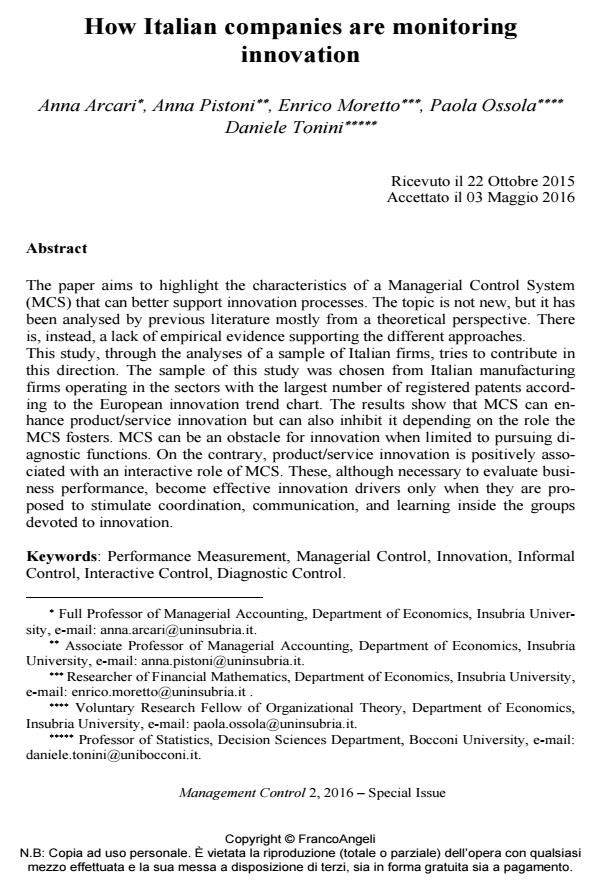How Italian companies are monitoring innovation
Titolo Rivista MANAGEMENT CONTROL
Autori/Curatori Anna Arcari, Anna Pistoni, Enrico Moretto, Paolo Ossola, Daniele Tonini
Anno di pubblicazione 2016 Fascicolo 2016/2
Lingua Inglese Numero pagine 23 P. 143-165 Dimensione file 279 KB
DOI 10.3280/MACO2016-002007
Il DOI è il codice a barre della proprietà intellettuale: per saperne di più
clicca qui
Qui sotto puoi vedere in anteprima la prima pagina di questo articolo.
Se questo articolo ti interessa, lo puoi acquistare (e scaricare in formato pdf) seguendo le facili indicazioni per acquistare il download credit. Acquista Download Credits per scaricare questo Articolo in formato PDF

FrancoAngeli è membro della Publishers International Linking Association, Inc (PILA)associazione indipendente e non profit per facilitare (attraverso i servizi tecnologici implementati da CrossRef.org) l’accesso degli studiosi ai contenuti digitali nelle pubblicazioni professionali e scientifiche
The paper aims to highlight the characteristics of a Managerial Control System (MCS) that can better support innovation processes. The topic is not new, but it has been analysed by previous literature mostly from a theoretical perspective. There is, instead, a lack of empirical evidence supporting the different approaches. This study, through the analyses of a sample of Italian firms, tries to contribute in this direction. The sample of this study was chosen from Italian manufacturing firms operating in the sectors with the largest number of registered patents according to the European innovation trend chart. The results show that MCS can enhance product/service innovation but can also inhibit it depending on the role the MCS fosters. MCS can be an obstacle for innovation when limited to pursuing diagnostic functions. On the contrary, product/service innovation is positively associated with an interactive role of MCS. These, although necessary to evaluate business performance, become effective innovation drivers only when they are proposed to stimulate coordination, communication, and learning inside the groups devoted to innovation.
Parole chiave:Performance Measurement, Managerial Control, Innovation, Informal Control, Interactive Control, Diagnostic Control
- Preventing crises and managing turnaround processes in SMEs The role of economic measurement tools Anna Maria Arcari, in MANAGEMENT CONTROL 3/2018 pp.131
DOI: 10.3280/MACO2018-003007 - High Performance Through Innovation Process Management in SMEs. Evidence from the Italian wine sector Simona Alfiero, Laura Broccardo, Massimo Cane, Alfredo Esposito, in MANAGEMENT CONTROL 3/2018 pp.87
DOI: 10.3280/MACO2018-003005 - Management accounting systems in venture capital-backed start-up companies Simone Aresu, Luigi Rombi, Andrea Cardia, in MANAGEMENT CONTROL 3/2019 pp.35
DOI: 10.3280/MACO2019-003003
Anna Arcari, Anna Pistoni, Enrico Moretto, Paolo Ossola, Daniele Tonini, How Italian companies are monitoring innovation in "MANAGEMENT CONTROL" 2/2016, pp 143-165, DOI: 10.3280/MACO2016-002007